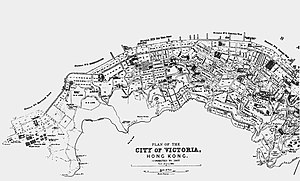|
Victoria, Hong Kong
The City of Victoria,[2] (Chinese: 維多利亞市,[3] or 維多利亞城)[4] often called Victoria City or simply Victoria (Chinese: 維城), was the de facto capital of Hong Kong during its time as a British dependent territory.[5] It was initially named Queenstown but was soon known as Victoria.[6] It was one of the first urban settlements in Hong Kong and its boundaries are recorded in the Laws of Hong Kong.[7] All government bureaux and many key departments still have their head offices located within its limit. Present-day Central is at the heart of Victoria City. Although the city expanded over much of what is now Kennedy Town, Shek Tong Tsui, Lung Fu Shan, Sai Ying Pun, Sheung Wan, Wan Chai, Happy Valley, the Mid-Levels, East Point and parts of Causeway Bay,[8] the name Victoria has been eclipsed by Central in popular usage.[9] However, the name is still used in places such as Victoria Park, Victoria Peak, Victoria Harbour, Victoria Prison, and a number of roads and streets. It is also retained in the names of various organisations such as the Victoria City District of the Hong Kong Scout,[10] and the Victoria Junior Chamber.[11] The name Victoria District Court had been used into the 1980s,[12][13][14][15] when it was moved to the Wanchai Tower and combined with other district courts in the territory. History"City of Victoria" had appeared on the statute books early in the 1845,[16] although names such as "Town of Victoria" can be found as well.[17] Letters patent that formally confers the city status and creates the City of Victoria was made on 11 May 1849.[1] In 1857, the British government expanded the scope of Victoria City and divided it into four wans (Chinese: 環; Jyutping: waan4; lit. 'rings'):
"Sai Wan", "Sheung Wan" and "Choong Wan" retain the same Chinese name today. The four wans are further divided into nine yeuks (約, similar to 'district' or 'neighbourhood'). The coverage also included parts of East Point and Happy Valley (west of Wong Nai Chung Road on the east side of the racecourse). In 1903, boundary stones were established to mark the city's boundary and six of them are still preserved today. The stones spread from Causeway Bay to Kennedy Town.[18] In the 1890s, Victoria extended four miles west to east along the coastal strip. Buildings were made of granite and brick. Buses and the new tramway would become the main form of transportation in the area.[19] The city is centred in present-day Central, and named after Queen Victoria in 1843. It occupies the areas known in modern times as Central, Admiralty, Sheung Wan, Wan Chai, East Point, Shek Tong Tsui, the Mid-levels, the Peak, Happy Valley, Tin Hau, and Kennedy Town, on Hong Kong Island. Boundaries The city boundaries are defined in the laws of Hong Kong as follows:[2]
First streetsAccording to the 1845 map of Victoria City, 16 streets were initially named for the city. These streets exist mainly in the areas of Central and the Mid-Levels, with two being in Sheung Wan. These street names were finalised by the second Governor of Hong Kong, Sir John Francis Davis. All 16 streets were named after persons of great prominence in Great Britain or in Hong Kong, with the location and layout determined according to the position and prominence of the person being named after: Boundary stones In 1903, the Hong Kong Government erected several boundary stones to mark the limits of Victoria, measuring 98 cm in height, tapered at the top and with the inscription "City Boundary 1903". As the city’s boundaries were clearly defined by ordinance, these stones were more just physical markers.[20] Three additional boundary stones were found in 2021,[21] adding the total of discovered stones to 10, including the one disappeared in June 2007.[22]
Districts  In 1866 the nine districts, also called yeuks, are:[26]
Other places that might be considered as yeuks include: Territorial DesignationOn 21 May 1982, Sir Crawford Murray MacLehose was made a life peer, weeks after the end of his governorship in Hong Kong. His peerage was announced on 31 December 1981 in the 1982 New Years Honours. He was therefore styled as Baron MacLehose of Beoch, of Maybole in the District of Kyle and Carrick, and of Victoria in Hong Kong. Victoria was listed as the barony's territorial designation, alongside MacLehose's hometown Maybole. The Barony went extinct on 27 May 2000 when MacLehose passed away. [27][28] See also
References
External linksWikimedia Commons has media related to Victoria City. Look up Victoria in Wiktionary, the free dictionary.
|
|||||||||||||||||||||||||||||||||||||||||||||||||||||||||||||||||||||||||||||||||||||||||||||||||||













